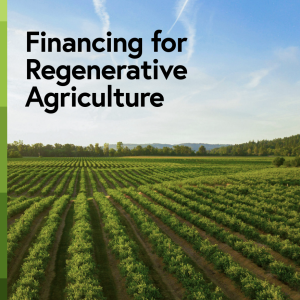
The report by Rockefeller Foundation, Pollination Group and Transformational Investing in Food Systems makes the case for more investment in regenerative agriculture, arguing that investors underestimate and mischaracterize the risks involved in conventional agriculture. It suggests that a transition to regenerative food systems will not only create positive social and environmental benefits but also significant financial returns.
Publisher’s summary
Business as usual is no longer viable. Agrifood systems contribute over a third of global greenhouse gas emissions. Land degradation reduces productivity in 23% of global terrestrial area, and pollinator loss jeopardises USD $230 - $580 billion in annual crop output.3 Through the lens of health, over 800 million people struggle with hunger, and nearly a third of the global population experience diet related illnesses.
The hidden environmental, health, and social costs of global agrifood systems equate to nearly USD $20 trillion each year.5 Meanwhile, steady depletion of natural resources threatens the long-term productivity of food systems, with climate change further exacerbating supply chain volatility and endangering producer livelihoods. A shift to regenerative agriculture and food systems unlocks new opportunities.
The funding gap to shift conventional global food systems to regenerative is estimated between USD $250 - $430 billion annually for 10 years.6 Closing the gap would unlock USD $4.5 trillion in new investment opportunities per year (~13x the investment cost) and $5.7 trillion of costs per year saved in damages to people and the planet (~16x the investment cost).7 The risks and returns of agrifood investments must be rebalanced.
Many investors are aware of climate risks, but few consistently integrate relevant risk management factors into investment processes. As a result, current assessments mischaracterise the risks and returns of conventional vs. regenerative agriculture. Consideration of the long-term profitability and resilience benefits of regenerative agriculture has yet to be factored into investor risk ratings. However, regenerative farmers and regenerative businesses do more than return financial investments. They build strong regional economies and resilient value chains, increase the availability of healthy food, and protect nature. These systemic returns regenerate the natural and social impacts highlighted above.
Today, we are in the early stages of transitioning to regenerative food systems. The path forward is difficult and messy, but as this report demonstrates, there are ways for investors to help advance the transformation process. Both commercial and concessional capital providers play a key role in accelerating capital deployment for regenerative agriculture. And while these moves can create positive externalities for people and the planet, they will also create hearty financial rewards.
Read more here. See the TABLE explainer, What is regenerative agriculture?












Post a new comment »